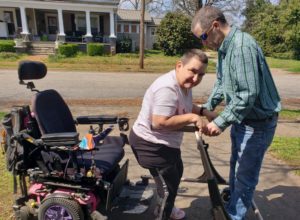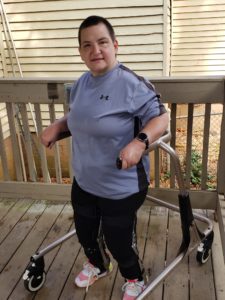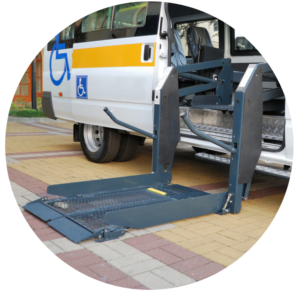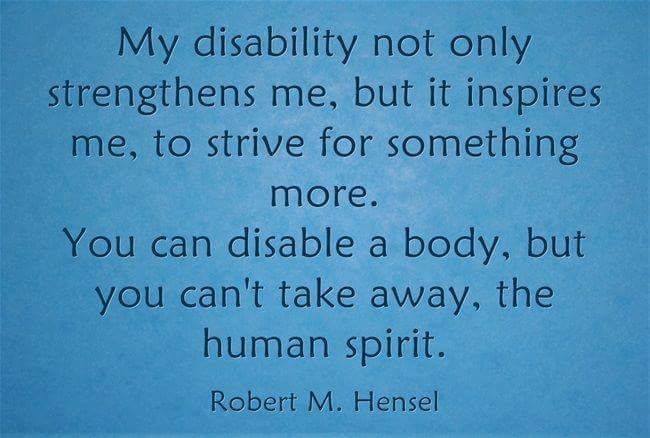
From the day she was born, life has been a challenge for Mia Henson. Her mom went into labor when she was six months pregnant. Doctors gave her injections to stop labor which may have caused Mia’s brain to hemorrhage before she even entered the world.
“I weighed two pounds, 15 ounces at birth, and remained in the hospital for three months,” Mia said.

To put that in perspective, the average healthy birth weight is 7.5 lbs. At six months, a baby has fully formed lungs, fingerprints and can hear sounds outside the womb. However, problems can occur with injections that stop labor, and cerebral palsy is one of them. Barring those injections, there are still plenty of risk factors for delivering at 24 weeks. According to the Centers for Disease Control, the survival rate for babies like Mia, referred to as micro-preemies, is 39%. Low birth weight is also linked to a higher risk of disabilities and other health problems.
Mia was born in 1972. At the time, ethanol or terbutaline were being used to halt labor. Neither was approved, then or now, by the Food and Drug Administration. She thinks the terbutaline was used in her mother’s case but isn’t sure. Whether from the injections or being born at 24 weeks, she came into the world with cerebral palsy.
Determined to persevere
“I have never walked independently. I’ve been in a wheelchair since I was four years old. Before that, I crawled. Even as an adult, I often resorted to crawling because I could get around my house quickly that way, but it was embarrassing to me even if no one else was around.”

But David Lewis was around. He is a friend and has been Mia’s roommate for about 20 years. They support each other in a way some of us could never understand.
“David is mentally challenged. I am physically challenged. I help him mentally, and he helps me physically. Basically, we make a complete person,” Mia explained.
For most of her life, she just didn’t care what David or anyone thought, but a couple of years ago, something clicked inside Mia. She was determined to be more independent. She looked around her house and located some braces she had for years. Mia’s goal was to be independent in her own home, to be able to transfer herself from her wheelchair to her bed and to be able to do some household tasks.
“So I started standing with those braces every day, and just standing up against the wall was scary because the vibrations of someone walking across the floor made me feel as if I would fall. But I kept with it, at first to impress my friends that I could do it, and I ended up impressing myself.”
Turning to a professional
When she went as far as she could on her own, Mia turned to a physical therapist. Some told her it wouldn’t help. Some therapists refused to work with her. Finally, she found a PT that would match her professional training to Mia’s efforts. They proceeded to work on gait training and balance.

“I hate being in a wheelchair. I want to walk, at least in my house, and I finally felt like I was in the right place because my therapist, Peery Moran, pushes me and knows I won’t quit, and doesn’t tell me what I want to hear, but what I need to hear to move forward because I don’t want to be waited on anymore.”
Mia says the physical therapy sessions work. She has been able to do a sit-up for the first time in 15 years and is obviously getting stronger. Unfortunately, her PT sessions have been cut from twice a week to once a week because of insurance coverage.
Medical insurance is a different world for people with physical or mental disabilities and it is a constant struggle. It’s a reality that I am very aware of as the mother of a double amputee. I used to get questionnaires from my insurance company each time we submitted a claim for new prosthetics, which my son outgrew like your children would outgrow shoes. They asked, “Did he get hurt on the job?” My response was, “No, he is only five years old.”
Almost 600 days of progress and counting

Mia not only tracks each day of progress but for almost 600 days she has posted pictures of standing in her braces and for exactly how long to her social media page. She wants to be accountable to all those who follow her.
“I don’t do this to inspire others but to be a better me.”
On the other hand, Mia knows that because people follow her journey, her persistence and progress could be helpful.
“We are all struggling with something. I know I am physically challenged and differently-abled, but there are people in worse situations. We need each other. We need to be inspired.”
Mia firmly believes the only disability is a bad mindset and attitude. She has neither.
“If I can bring someone out of a dark place, that’s great because I’ve been there and done that.”
Transportation challenges
When you can’t drive, depending on public transportation is critical. Mia lives in Stewart County, Georgia, which is about a quarter of the size of Habersham County.
In many smaller communities across Georgia, public transportation serving those struggling with disabilities or the elderly is almost nonexistent. Not so in Habersham County, which makes about 184 trips each month to transport folks to doctor’s appointments, the grocery store, or other essential destinations.

According to Serena Freeman, the Transit Coordinator for Habersham County Public Transportation, “We have two buses which are lift-equipped and maintained by a grant through the Georgia Department of Transportation. They are checked daily to ensure timely pick-ups for those in need.”
Their drivers are also trained in the proper way to help people with disabilities. Many of their riders are regulars who utilize the service frequently.
“Anyone in need of public transportation in Habersham County can call, 706-839-0167, Monday through Friday between 7:00 am and 4:00 pm to schedule a pick-up appointment. The rate is .60 per mile and .50 for each additional stop,” according to Freeman.
That is good news for the 16% of the population of Habersham County, or 6,598 recognized as having disabilities, according to The National Institute on Disability. That number is higher than average for Georgia, as are the statistics for White and Stephens counties.
What lies ahead
Despite insurance challenges, occasional transportation issues, and physical therapy ups and downs, Mia is determined not to be bound by her wheelchair, especially in her own home.
She didn’t start her present journey to inspire, but that she has.
“I want people always to remember my zest for life, my love for my family and friends, and my positive mindset. That despite having cerebral palsy, cerebral palsy does not have me. When I leave this world, I want people to think they can’t give up because Mia would be disappointed.”
When you feel down and out, when life hands you setbacks, remember Mia and thousands like her who are differently-abled and think about her favorite quote:

Go, Mia! We are cheering for you!







